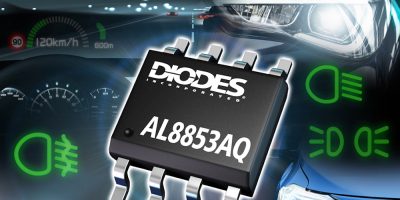Boost/SEPIC controller enables 50kHz LED-wide PWM dimming
Automotive lighting applications can be enhanced with a reduced bill of materials, said Diodes, with the AL8853AQ, a boost/single-ended primary inductance converter (SEPIC) controller for automotive LED applications.
The AL8853AQ is an automotive-compliant and highly integrated boost/SEPIC controller that provides a reduced bill of materials (BoM) in automotive LED applications including exterior lights, headlamps, head-up displays (HUD), and backlight displays.
Automotive headlamp manufacturers can use SEPIC topology to enable high or low beam LED array drivers that operate directly from a vehicle’s battery, instead of using the conventional two-stage topology of a boost followed by a buck converter or a full-bridge, buck-boost topology. The SEPIC functionality of the AL8853AQ supports cost-effective, simple buck-boost-like topology, which is suitable for HUD systems in automotive designs.
The wide input range of 6.0 to 40V of the AL8853AQ supports a typical 12V vehicle battery voltage input. Its 200mV feedback reference voltage has ± three per cent tolerance to maintain tight brightness control while improving efficiency. The fixed 400kHz switching frequency of the AL8853AQ supports low electromagnetic interference (EMI) by using a fundamental frequency outside the medium wave (MW) band. This controller’s fast (50kHz) pulse width modulation (PWM) to analogue dimming mode (100 per cent down to one per cent) prevents visible low or high-frequency flickering usually associated with PWM dimming.
The AL8853AQ also includes robust protection features to guard against unexpected over-voltage, over-current, over-temperature and diode and inductor short-circuit events.
The AL8853AQ is qualified to AEC-Q100 Grade 1, manufactured in IATF 16949 certified facilities, and is PPAP-capable. The controller is available in a SO-8 package.
Diodes delivers semiconductor products to customers in the automotive, industrial, computing, consumer electronics, and communications markets. Its product portfolio consists of discrete, analogue and mixed-signal products and packaging technology. The range of application-specific solutions coupled with worldwide operations of 32 sites, including engineering, testing, manufacturing, and customer service.




